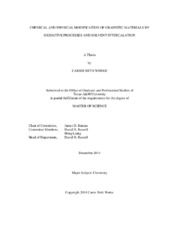| dc.description.abstract | Graphene and graphite are materials of high interest for many applications. In order to increase the possible uses of these materials, more must be understood about how their properties can be modified. One way to modify graphitic properties is by chemical functionalization, such as oxidation. This work looks at two different oxidation techniques for graphite; UV/O3 exposure and biased AFM lithography for broad and local oxidation, respectively. For the supported graphitic samples including graphene, it is important to understand how sample preparation can lead to contamination in addition to investigating how to chemically and physically manipulate the graphitic properties. Three different mechanical exfoliation sample preparations were used to create samples, and each method was investigated with biased lithography.
UV/O3 exposure is able to form graphite oxide with only the exposed area undergoing oxidation. It was found that the length of exposure time could be linearly correlated to the amount of defects as determined by Raman spectroscopy. Biased AFM lithography of graphite was also able to oxidize graphite, in a localized pattern instead of entire exposed area. By controlling the lithography conditions, the extent of oxidation in an area could be manipulated.
Supported graphitic materials were created via Scotch tape, thermal release tape and water soluble tape. Each tape had unique sample preparation conditions, and each of the three samples yielded single to multilayer graphene surfaces which then underwent biased lithography. Biased lithography on each of these created surfaces demonstrated the impact that sample preparation had on device creation as the samples had unique responses based on which method was used. Scotch tape samples saw growths stemming from the graphitic areas that underwent the biased lithography, thermal release tape samples formed wrinkles in the graphitic region while donuts, on the edges, and the water soluble tape showed oxidation of the graphitic region as well as the formation of bubbles. These bubbles are believed to be due to the solvent intercalation which was able to undergo electrolysis, a novel method for graphitic bubble formation. | en |


